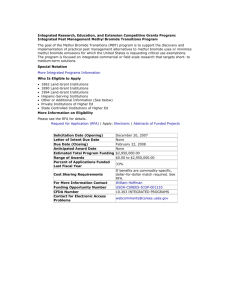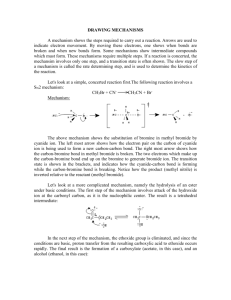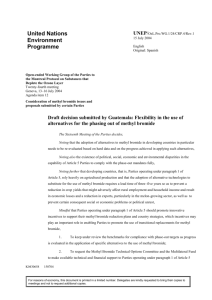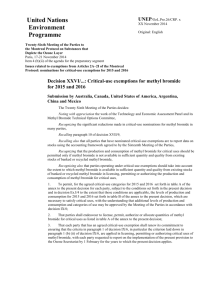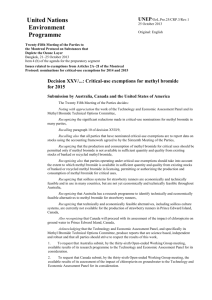PRELIMINARY RESULTS EVALUATING GAS FUMIGANTS RELEASED THROUGH VARIOUS MULCHES 2005
advertisement
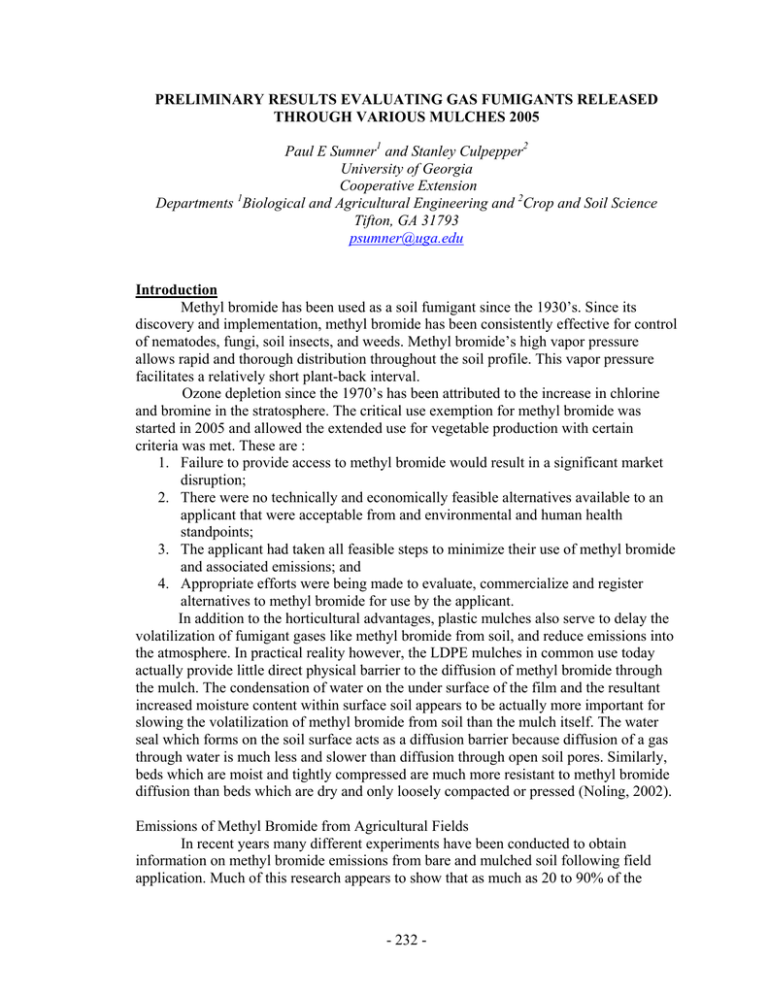
PRELIMINARY RESULTS EVALUATING GAS FUMIGANTS RELEASED THROUGH VARIOUS MULCHES 2005 Paul E Sumner1 and Stanley Culpepper2 University of Georgia Cooperative Extension Departments 1Biological and Agricultural Engineering and 2Crop and Soil Science Tifton, GA 31793 psumner@uga.edu Introduction Methyl bromide has been used as a soil fumigant since the 1930’s. Since its discovery and implementation, methyl bromide has been consistently effective for control of nematodes, fungi, soil insects, and weeds. Methyl bromide’s high vapor pressure allows rapid and thorough distribution throughout the soil profile. This vapor pressure facilitates a relatively short plant-back interval. Ozone depletion since the 1970’s has been attributed to the increase in chlorine and bromine in the stratosphere. The critical use exemption for methyl bromide was started in 2005 and allowed the extended use for vegetable production with certain criteria was met. These are : 1. Failure to provide access to methyl bromide would result in a significant market disruption; 2. There were no technically and economically feasible alternatives available to an applicant that were acceptable from and environmental and human health standpoints; 3. The applicant had taken all feasible steps to minimize their use of methyl bromide and associated emissions; and 4. Appropriate efforts were being made to evaluate, commercialize and register alternatives to methyl bromide for use by the applicant. In addition to the horticultural advantages, plastic mulches also serve to delay the volatilization of fumigant gases like methyl bromide from soil, and reduce emissions into the atmosphere. In practical reality however, the LDPE mulches in common use today actually provide little direct physical barrier to the diffusion of methyl bromide through the mulch. The condensation of water on the under surface of the film and the resultant increased moisture content within surface soil appears to be actually more important for slowing the volatilization of methyl bromide from soil than the mulch itself. The water seal which forms on the soil surface acts as a diffusion barrier because diffusion of a gas through water is much less and slower than diffusion through open soil pores. Similarly, beds which are moist and tightly compressed are much more resistant to methyl bromide diffusion than beds which are dry and only loosely compacted or pressed (Noling, 2002). Emissions of Methyl Bromide from Agricultural Fields In recent years many different experiments have been conducted to obtain information on methyl bromide emissions from bare and mulched soil following field application. Much of this research appears to show that as much as 20 to 90% of the - 232 - methyl bromide applied to a given field can ultimately out-gas through the LDPE plastic mulch cover and into the air after soil fumigation. Many different chemical, soil, and environmental factors interact to cause the wide variation of reported emission losses from soil with methyl bromide. In general, the rates in which methyl bromide volatilizes from soil under typical conditions are initially high following application and then decrease with time, such that after 5 to 7 days post application, little remains in soil (Figure.1). Data is plotted only to show general decline in emissions with time, and highest daily rates of emission occurring midday and lowest emissions at night. Besides temperature, other soil and environmental conditions can modify methyl bromide emissions from soil greatly. Figure 1. Generalized representation of the relative emissions of methyl bromide volatilizing through a plastic mulch cover with time after initial soil fumigation. (Noling 2002) Mulch Permeability The permeability (the ability to pass through) of a plastic mulch to methyl bromide is based on the thickness, density, and chemical composition of the plastic mulch. Regardless of composition, thicker mulches are generally less permeable to methyl bromide than are thin mulches (Figure 2). In most cases, practical and cost efficiency considerations prevent the use of thicker LPDE mulches for enhanced containment of methyl bromide in soil. Some plastic mulches provide better diffusion barrier to certain fumigants than others. For example, permeability to methyl bromide decreases as the density of a mulch increases. High density polyethylene (HDPE) mulches are less permeable to methyl bromide than LDPE mulches. Objectives 1. Determine a method measure rate of gas movement through mulches used in vegetable production. 2. Measure the amount of gas movement of methyl bromide, methyl iodide and chloropicrin through various mulches. - 233 - Figure 2. Permeability of methyl bromide (Mbr), Chloropicrin (Pic), and two isomers of 1,3-Dichloropropene (Telone) through high density polyethylene (HDPE) plastic mulch of two thicknesses. (Noling 2002) Methods and Materials Plot land was prepared for commercial squash production. Soil type is Tifton sandy loam. Four mulch films were obtained. They were LDPE(black/white embossed), metallized black embossed, virtually impermeable(VIF)1, and VIF2. Methyl bromide, methyl iodide and Telone II and Chloropicrin were the fumigants used in the test. At the time the beds were formed soil moisture was ideal for soil fumigation and bed formation. Each fumigant gas was measured with a gas detector pump (GASTEC GV100S) with detector tubes for each. Plastic funnels measuring 8 inches were glued to mulch beds to be used to collect gases as they pass through the mulch (Figure 3). Gas detector tubes were used to measure the fumigant gasses in ppm. The range used were methyl bromide (400-30 PPM), methyl iodide (90-3 ppm), and chloropicrin (80-3ppm). Figure 3. Plastic funnels installed to collect gas fumigants released through various mulches. Results and Discussion Plots had fumigants and films applied on July 14, 2005. Fumigants were applied in 6 feet by 25 feet plots. Table 1 are the rates used for the test. - 234 - Funnels with rubber stoppers were glued to the films immediately after fumigation. Samples of the air in the funnels were taken 24 hours after application of the fumigants. Stoppers were removed and a gas levels detected in the funnels were out of range for the detection tubes used. Stoppers were removed and funnels were left open. On day 2, air was sampled from the funnel. This sample indicated gases could be measured. Fumigant gas was measured every day in the funnels with no stoppers for the following 3 days or until no gases were detected. Plots of the measured gases are shown in figures 46. Table 1. Fumigants and rates used on various mulches. Fumigant Mixture Rate Methyl Bromide (67:33) 400 lbs/acre Methyl Iodide (50:50) 400 lbs/acre Telone II 6gal/acre Chloropicrin 150 lbs/acre Vapam 75 gallons Actual Rate 300 lbs/acre 200 lbs/acre 150 lbs/acre Measure Methyl Bromide (300 lb/acre) Above 1.25 mil Mulch LPDE VIF1 Metallized VIF2 100 (ppm) 80 60 40 20 0 2 3 4 Days After Application Figure 4. Measured methyl bromide fumigant gas (300 lb/acre) through various mulches. - 235 - Measured Methyl Iodide(200 lbs/acre) Above 1.25 mil Mulch LPDE VIF1 Metallized VIF2 30 (ppm) 25 20 15 10 5 0 2 3 4 Days After Application Figure 5. Measured methyl iodide fumigant gas (200 lb/acre) through various mulches. Measured Chloropicrin (150 lbs/acre) Above 1.25 mil Mulch (ppm) LPDE Metalized VIF2 6 5 4 3 2 1 0 2 3 Days After Application Figure 6. Measured chloropicrin fumigant gas (150 lb/acre) through various mulches. A method was determined to obtain measurable values of gas fumigants through mulches used in vegetable production. The LDPE had the least amount measured gas above the mulch for all fumigants in this test. It appears that the VIF2 mulch slowed the chloropicrin gas as well as LDPE. Due to determining sampling methodology fumigants gas were not measured on day of application and 1 day after application. This test will be conducted again in 2006. - 236 - References Noling, J.W. 2002. Reducing Methyl Bromide Application Rates with Plastic Mulch Technology. Entomology and Nematology Department, Florida Cooperative Extension Service, Institute of Food and Agricultural Sciences, University of Florida. ENY-046. - 237 -
